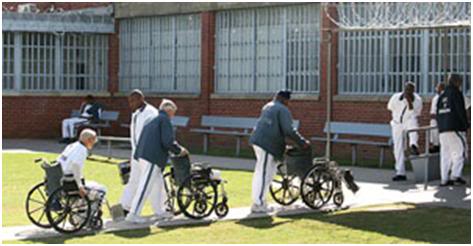Older inmates are posing a new problem for Canada's prison system. The Correctional Service of Canada is developing a strategy to adapt the system, but it may come too late to meet the needs of many elderly inmates.

An aging prison population is somewhat of a recent problem in our country. This is reflective of larger social demographics and an aging population overall. After all, as our general population ages, so does the prison population.
Moreover, the median age of offenders entering the prison system has risen significantly over the years. It's now at 33.
This creates an older population off the bat, which is only compounded by the fact that one in four inmates in Canada is now over the age of 50. In fact, many Canadian prisons are now reporting an overall population where more than half the inmates are aged 50 or older.
But what's the big deal? A 50-year-old person in Canadian society is not considered a senior.
However, the same simply does not hold true behind bars. Due to poorer conditions, individuals over the age of 50 fall in the "aging" category among all prison populations. It is generally accepted that, in order to reflect the relatively dismal health and living conditions experienced by inmates, an average of 10 years can be added to their chronological age. This means that prisoners aged 50 or older are, by definition, eldery, which translates into more problems for them, as well as the prison system on a whole.
The biggest challenge facing our correctional service is the cost associated with caring for elderly prisoners.
Aging inmates are more prone to experience chronic health problems, such as diabetes. They are also much more likely to suffer from conditions that will affect their mobility.
This can prove challenging while living behind bars. Aging inmates are often unable to navigate the prison grounds, which were designed with a much younger, more able-bodied population in mind. Buildings are often positioned far away from one another, and laden with stairs. Cells are not designed to accommodate wheelchairs or medical equipment such as oxygen tanks, for example.
And this is only one of the many practical challenges facing older inmates and Canada's correctional service.
Another problem has to do with programming. Rehabilitative and recreational programs are no longer suited to the changing needs of many older, more mature prisoners. With a focus on equipping younger inmates with educational and vocational skills in order to reintegrate them into society by increasing their employment opportunities, aging inmates are finding it difficult to relate. This does little to achieve the fundamental objectives of our correctional institutions.
But it's not just inmates who are suffering as a result of inadequate housing structures and a distinct lack of sufficient care behind bars — taxpayers are suffering as well. This is particularly so due to the fact an aging inmate population is the most expensive demographic to incarcerate.
Solutions, however, are not easy to come by.
Some people have suggested compassionate release for elderly inmates. This would mean that they would be free to live the rest of their days out in the community, in either assisted-living or palliative-care facilities.
While Canada does allow for the compassionate release of terminally ill patients with no hope of recovery, this occurs in only very limited circumstances. In my view, it is an inappropriate solution to the problem of aging prison populations.
Elderly offenders cannot be issued with a literal "get out of jail free" card solely as a result of their age. This would undermine public confidence in our criminal justice system, and pose a potential threat to our communities at large. After all, elderly offenders can still be violent and dangerous, and may threaten vulnerable communities if they were to be released into them without adequate supervision.
Others have suggested building new facilities and overhauling our prison system altogether to more appropriately meet the needs for an aging population. While this seems ideal, it is impractical. The burden on taxpayers would be enormous.
The simple fact is that there is no simple, pre-existing solution to this issue. A multifaceted and dynamic approach will be required.
For starters, it would be wise for the Correctional Service of Canada to develop more appropriate programming and resources for an aging prison population. These should be tailored to meet both the physical and mental needs for prisoners.
Renovations and improvements to existing prison facilities should be made with elderly inmates in mind as well.
Finally, the correctional service may also want to consider hiring and training staff with experience in palliative care and working with an elderly population. These people would be in a better position to care for the unique needs associated with an aging population, and to meet them in an appropriate and humane manner.
If these changes are implemented, they should support greater health among aging prisoners, which will, in turn, create less of a strain on our prison system and taxpayer dollars.
But we need to act quickly—before it is too late, both for us and them.
Sarah E. Leamon
HuffPost Canada
Jan 25, 2018
Hi! I am a robot. I just upvoted you! I found similar content that readers might be interested in:
http://www.huffingtonpost.ca/sarah-e-leamon/aging-prison-populations-require-a-creative-solution_a_23341350/
Downvoting a post can decrease pending rewards and make it less visible. Common reasons:
Submit
WARNING - The message you received from @amriremensss is a CONFIRMED SCAM!
DO NOT FOLLOW any instruction and DO NOT CLICK on any link in the comment!
For more information, read this post: https://steemit.com/steemit/@arcange/phishing-site-reported-uppervotes-dot-ml
Please consider to upvote this warning if you find my work to protect you and the platform valuable. Your support is welcome!
Downvoting a post can decrease pending rewards and make it less visible. Common reasons:
Submit